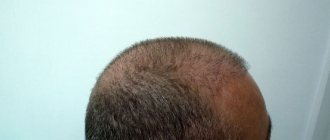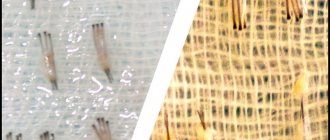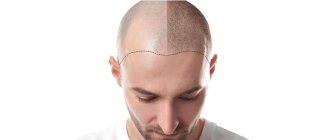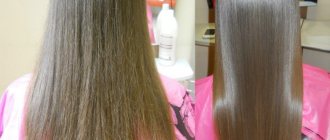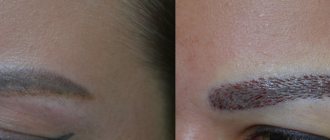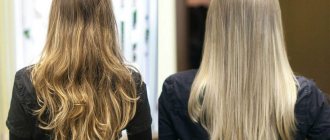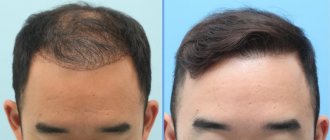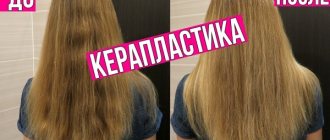What photo do you think is of the popular Hollywood handsome actor from “The Mummy” Brendan Fraser?
Brendan Fraser with and without hair.
The correct answer is both. But Brendan on the left is losing heavily to his right. And not at all because of the T-shirt.
Now compare photos of the “eternal superhero” Kevin Costner before and after hair restoration.
Kevin Costner before and after FUE hair transplant.
Thinning and hair loss makes the image weak, and even against the background of general youthfulness and high muscle tone, it adds 10-15 years to Kevin.
These photos clearly demonstrate how much weak hair “kills” the image. And trichologists confirm our observation. Not everyone with a charismatic and attractive face has the beautiful skull of Bruce Willis, which will maintain this charisma even after the hair disappears.
Baldness is one of the most painful problems not only for actors. Indeed, wrinkles can be smoothed out, sportswear can be tightened, and the shape of the ears can be corrected. But what to do with your hair if it falls out?!
John Travolta, Matthew McConaughey, Tom Hanks lost the fight against nature... And although no one doubts the irresistibility of these men, their image still requires hair as strong as themselves. Therefore, they all underwent HFE hair transplant.
Expert comment:
Make an appointment
“Alopecia is not a fatal disease. But if possible, it is definitely worth doing a transplant. There is only one exception - the tendency to total alopecia - complete loss of hair.
In this case, the donor area on the back of the head will simply not be enough to restore the lost hair in other areas.”
Mamontova Tatyana, transplant surgeon. Treatment of baldness in men usually begins with medications, shampoos, ointments and balms. But none of them solves the problem radically, and some professional medications contain hormones that negatively affect potency.
We at Platinental offer the most modern and effective way to combat baldness - hair restoration using the HFE (Hand Follicular Extraction, HFE) method. Its second name is hair transplantation using the FUE (Follicular Unit Extraction, FUE) method. This is a manual single hair transplant. The procedure is completed in one day. It does not require shaving your head and does not leave a scar. You get hair that grows throughout your life and never falls out.
What is HFE hair transplant
The CFE method differs from all other methods in that the collection of single hairs for transplantation is carried out manually.
This is the only method that practically does not injure the hair and scalp and, in professional hands, allows you to obtain a result indistinguishable from natural.
Hair transplant process
Preparation for hair transplant
Preparation begins from the moment the patient begins to undergo the examination prescribed by the doctor. If the results fail to identify contraindications for transplantation, the patient must adhere to a number of rules:
refusal of medications to stop hair loss (2 weeks before transplantation)
one week before the appointed date, it is forbidden to take medications,
affecting blood clotting;
quitting smoking and drinking alcohol;
on the day of the operation, the donor area (most often the back of the head)
cut short (to hair length 1–2 mm).
What does the head look like immediately after hair transplantation? Result of hair transplant - Ivan Pavlovich Chesalin
Male hair transplant. Hair transplant using FUE method. How is hair transplant performed in men?
Hair transplant in progress. Hair transplantation method FUE. Ivan Pavlovich Chesalin
The duration of hair transplantation depends on the area of alopecia and varies from 4-5 hours to 7-8 hours.
Primary rehabilitation after hair transplantation is 10-12 days. Immediately after the operation, it is not recommended to drive a car. For the first two weeks, you should avoid physical activity. All dressings and treatments are carried out in the clinic. The patient is given detailed recommendations for home care, which he must carefully follow.
| Hair transplantation into the beard area - Dr. Ivan Palovich Chesalin Prices include the promotion with a 50% discount with permission to publish the results of photos and videos | |
| Initial comprehensive consultation | Without payment |
| Cost of hair transplantation in the first degree beard area | 110,000 rubles instead of 220,000 rubles, subject to publication of the results |
| Cost of hair transplantation in the beard area of the second degree | 140,000 rub. instead of 280,000 rubles, subject to publication of the results |
| Cost of hair transplantation in the third degree beard area | 170,000 rub. instead of 340,000 rubles, subject to publication of the results |
| The price includes everything except tests. | |
Expand
| Hair transplantation of the scalp area - Dr. Ivan Palovich Chesalin Prices include the promotion with a 50% discount with permission to publish the results of photos and videos | |
| Initial comprehensive consultation | Without payment |
| Cost of hair transplantation in the area of the temporal part of the first degree | 190,000 rubles instead of 380,000 rubles, subject to publication of the results |
| Cost of hair transplantation in the area of the temporal part of the second degree | 210,000 rub. rub instead of 420,000 rub, subject to publication of the results |
| Cost of hair transplantation in the area of the temporal part of the third degree | 230,000 rubles instead of 460,000 rubles, subject to publication of the results |
| Cost of hair transplantation in the temporofrontal area of the first degree | 210,000 rubles instead of 420,000 rubles, subject to publication of the results |
| Cost of hair transplantation in the temporofrontal region of the second degree | 240,000 rubles instead of 440,000 rubles, subject to publication of the results |
| Cost of hair transplantation in the temporofrontal region of the third degree | 265,000 rubles instead of 530,000 rubles, subject to publication of the results |
| Cost of hair transplantation in the occipital region of the first degree | 238,000 rubles instead of 476,000 rubles, subject to publication of the results |
| Cost of hair transplantation in the occipital area of the second degree | 265,000 rubles instead of 530,000 rubles, subject to publication of the results |
| Cost of hair transplantation in the occipital region of the third degree | 285,000 rubles instead of 570,000 rubles, subject to publication of the results |
| Cost of hair transplantation in the area of the temporo-frontal and occipital parts of the first degree | 275,000 rubles instead of 550,000 rubles, subject to publication of the results |
| Cost of hair transplantation in the area of the temporo-frontal and occipital parts of the second degree | 310,000 rubles instead of 620,000 rubles, subject to publication of the results |
| Cost of hair transplantation in the area of the temporo-frontal and occipital parts of the third degree | 360,000 rubles instead of 720,000 rubles, subject to publication of the results |
Expand
In the clinic, using the HFE method, we perform:
1. hair transplantation,
2. transplantation of long hair, without shortening it,
3. hair transplantation into scars after accidents, injuries, burns, radical operations and for cicatricial alopecia,
4. treatment of female pattern baldness,
5. beard, mustache and sideburns transplantation,
6. eyebrow transplant,
7. Formation of a beautiful hairline.
FUE hair transplant is the most modern method
The only effective method of combating baldness is hair transplantation from the patient's donor area to his problem areas. There are 2 fundamentally different ways to do this:
- operational method, or STRIP method
- non-surgical method, or FUE method
Until the 90s of the last century, the only transplant method was the STRIP method (from the English word strip). The essence of the method: a strip of skin with hair is cut out on the back of the head, then it is cut into small pieces - grafts, which are planted in the area of hair loss.
The FUE method began to be actively used in practice in the early 2000s, when scientists noticed that hair does not grow one by one, but in groups of 1-5 pieces. Such groups of hair roots are called units, follicular units or grafts.
Examples of grafts from one, two and three hairs.
The figure shows the hair collection area and grafts of 1, 2, 3 and 5 hairs.
This made it possible to make a revolutionary discovery - the units, along with the roots, can be manually removed and “replanted” - just like garden plants are replanted - with a lump of earth around the roots.
Expert comment:
“With surgical strip plasty, there is a risk of nerve damage and long-term numbness of the head during the process of obtaining the flap. In my practice, numbness and microtraumas never occur after FUE transplantation.
Restoration of the donor area after strip occurs with the formation of a scar, which does not allow wearing short haircuts.
The formation of rough scars during hair restoration using the HFE method is excluded.
With strip grafting there is a very high risk of damage to the graft, which negatively affects its viability and survival rate.
I only transplant hair with hand-extracted and full-fledged grafts.”
Mamontova Tatyana, transplant surgeon.
Hair transplantation using the HFE method is a very painstaking work, consisting of many important stages. After all, in case of baldness, it is important not only to transplant hair correctly. It is important to preserve the donor material as much as possible. And also make sure that no one guesses that the procedure took place.
To this end, within HFE we use many proprietary techniques and approaches. Therefore, below we will tell you not only about the HFE method, but also about all our secrets, which we meticulously use in hair transplantation.
FUE METHOD – FOLLICULAR UNIT EXCISION
The FUE method, according to the high standards of the HAIR&SKIN clinic, is a completely painless transplant method that does not leave scars. Thanks to the use of high technologies, the method is characterized by minimal trauma and the absence of a rehabilitation period. Many years of experience and jewelry precision allow you to get a natural result that lasts a lifetime in 3-4 hours.
The main advantages of the FUE method, carried out according to international standards:
- absence of seams, scars and damage to the skin in the area of graft extraction
- Each graft is removed manually, which allows for the least invasiveness and trauma
- Hair from any part of the body (for example, from the beard) can be used if there is no required number of donor grafts suitable for transplantation on the head
- no rehabilitation is required, the patient can return to normal life without restrictions, including sports
CONSULTATION
We take hair for transplantation only from the back of the head
Graft collection process
Expert comment:
“In 95% of cases, the cause of hair loss in men is androgenetic alopecia. In this case, the receptors of the hair follicles are sensitive to androgens - male sex hormones, or rather, to its variety - dehydrotestosterone (DHT).
Excess testosterone triggers the process of thinning and death of hair on the parietal and frontal scalp in men and areas along the parting in women.
The hair on the back of the head and on the sides of the skull is genetically insensitive to the effects of hormones, so these are the areas that become donor areas for transplantation.”
Mamontova Tatyana, transplant surgeon.
Results of female hair transplant
Alopecia is much less common in women than in men. The most common reason why women turn to specialists is loss of hair density. FUE transplantation can only be carried out if there is a sufficient supply of donor hair. Indications for transplantation are:
- focal, diffuse and androgenetic alopecia of the male type (female type baldness is not an obvious indication for transplantation and requires long-term observation by a specialist);
- high front growth line, deep “bald patches”;
- hair loss due to various injuries, illnesses, stress, external negative influences, lack of vitamins, and so on;
- congenital partial absence of hair;
- hereditary predisposition to baldness;
- genetically determined rare vegetation;
- aesthetic desire to increase the thickness of hair on the head, visually correct the shape of the forehead in the absence of a problem of hair loss;
- the need to cover scars with hair;
- thinning hair, resulting in loss of volume without hair loss.
Scalp hair transplantation using the FUE method is the most advanced method of modern transplantation. Compared to other scalp hair transplant techniques, the FUE technique has a number of significant advantages.
We collect hair without shaving the head
At the first stage, the hair collection area is cut off in the donor part of the head (usually the back of the head). The optimal length of hair in the donor area is 1.5 cm. On the one hand, this length reliably hides the consequences of hair collection, and on the other hand, it is convenient for extracting grafts.
Of course, the shorter the hair in this area, the easier it is for the doctor to work. But often aesthetics and the ability to quickly get back on track are more important. We meet our patients halfway and can completely preserve the length of donor hair. The cost of the procedure will increase slightly, but in this case the aesthetics of the head will be completely preserved. This is especially important when it comes to female transplantation.
Expert comment:
“Even with severe baldness, there are about 50,000 hairs on the back of the head that are not sensitive to testosterone. Of these, we can take and transplant 17,000 hairs!
If the hair is light and sparse, 15,000 grafts are available for transplantation so that the hairstyle does not lose volume due to the thinness of the hair. If the hair is dark and thick, up to 20,000 or more grafts are available for transplantation.
On the back of the head, the hair “looks” almost vertically down, and visually the fact of the fence will not be noticeable in any way.”
Mamontova Tatyana, transplant surgeon.
For patients from other cities and countries:
- Consultations via Skype, WhatsApp, Viber and email. We will answer all your questions.
- The cost of the procedure includes medications and scalp care products after the procedure.
- Free transfer from the airport to the hotel, as well as from the hotel to the clinic.
- Help with hotel reservations.
- Translation services.
- During the procedure: food, drinks, film or music.
- Postoperative consultations by email, phone, Skype, Viber or WhatsApp.
Hair does not fall out after transplantation
Since the hair on the back of the head is genetically insensitive to dehydrotestosterone , when transferred to a new location, it retains its properties and continues to grow throughout life.
The only exception is people with total alopecia, which is quite easy to predict - just study the hair behavior of your father and grandfathers. A transplant is not recommended for such people.
But there are exceptions to this rule. The famous English football player Wayne Rooney, despite the risk of total alopecia, has already undergone transplantation twice. And, in his words, he will fight until victory, just like on the football field.
Wayne Rooney
We do not injure the donor material during collection
The hair is recessed into the scalp up to 8 mm and almost never grows perpendicular to the surface. That’s why we at Platinental use a particularly gentle two-stage graft harvesting technique .
Hair collection is done manually using a special micropunch tool. It is a microtubule (0.5-0.9 mm) with a sharp edge.
We cut the skin around the graft with a punch, but only immerse it halfway into the skin - as shown in the picture. This way we insure ourselves against cutting the graft.
Then carefully pull out the follicle with tweezers. When extracting a hair, we keep it in a strictly defined place, because damage to the vital zones of the hair makes the unit unviable.
Only this approach allows you not to damage a single hair. For alopecia, this is very important, since the amount of hair in the donor area is limited.
That is why we carry out this stage of the procedure with special care and attention.
On the left is normal, on the right are units of hair damaged in some way that will not survive after transplantation.
We preserve the donor area during collection
We never take two adjacent units. Be sure to leave a ring of hair around the sampling point. This technique ensures healing without traces and reliably masks the donor areas on the back of the head.
Expert comment:
“If you take grafts continuously (and this is of course easier), restoration of the donor area will be problematic.
After healing, visible scars form on the head, which will not allow you to wear a short haircut in the future.
In our case, only points will remain that are not noticeable even with half a centimeter hair length.”
Mamontova Tatyana, transplant surgeon.
We never use tweezers for hair transplantation
A transplant using HFE is performed by implanting the extracted hair into the target area.
This is done using a special implanter tool - the English name is implanter pen.
The use of this unique tool makes it possible to avoid preliminary cuts of the skin in the hair planting area, as with strip plastic surgery. The follicles are immediately immersed to the desired depth and at the desired angle. They are almost not injured and take root well.
Types of scalp hair transplantation
- FUE - non-surgical, seamless transplantation of follicles removed from the donor area using a special tool - “punch”;
- HFE is a manual non-surgical transplantation of single follicles removed from the donor area using a special microtube (micropunch);
- FUT is an operable flap transplantation method in which a flap of skin is removed from the occipital region and divided into grafts.
| Hair transplantation of the scalp area for women - Dr. Ivan Palovich Chesalin Prices include the promotion with a 50% discount with permission to publish the results of photos and videos | |
| Initial comprehensive consultation | Without payment |
| Hair transplantation of scar area up to 3 sq cm | 45,000 rub. instead of 90,000 rubles, subject to publication of the results |
| Hair transplantation of scar area up to 5 sq cm | 69,000 rubles instead of 138,000 rubles, subject to publication of the results |
| Hair transplantation of scar area up to 7 sq cm | 85,000 rubles instead of 170,000 rubles, subject to publication of the results |
| Cost of hair transplantation in the area of the temporal part of the first degree | 190,000 rubles instead of 380,000 rubles, subject to publication of the results |
| Cost of hair transplantation in the area of the temporal part of the second degree | 210,000 rub. rub instead of 420,000 rub, subject to publication of the results |
| Cost of hair transplantation in the area of the temporal part of the third degree | 230,000 rubles instead of 460,000 rubles, subject to publication of the results |
| Cost of hair transplantation with first degree parting | 210,000 rub. rub instead of 420,000 rub, subject to publication of the results |
| Cost of hair transplantation with second degree parting | 230,000 rubles instead of 460,000 rubles, subject to publication of the results |
| Cost of hair transplantation with third degree parting | 245,000 rubles instead of 490,000 rubles, subject to publication of the results |
Sign up for a consultation
We achieve a survival rate of 96%
Yes, unlike other clinics, we do not promise a 100% survival rate, because in our calculations we take into account even accidentally lost grafts at the collection stage.
The peculiarity of our approach is that the grafts are stored in a special saline solution with the addition of stem cells until the very moment of planting. It stimulates further hair growth and ensures survival rate of up to 96%.
We are very sensitive to the material for transplantation, and we don’t even expose hair grafts to air - their overheating and drying out have an extremely negative effect on survival rate.
Hair transplant process
Local anesthesia is used to relieve pain during FUE surgery. At the first stage, donor material is collected. Unlike other techniques, FUE transplantation eliminates the need to cut the patient's head. It is enough to shave several thin stripes in the donor area, which can then be hidden by the hairstyle.
Using a “punch”, the skin is removed from the back of the head along with a group of hair roots. Next, microscopic punctures/incisions that do not require suturing are made in the receiving area, into which the grafts are placed using tweezers. The length of the hair in the receiving area also does not matter, which eliminates the need to cut off the natural hair. The duration of the operation is 5 - 8 hours, the duration depends on the degree and size of the bald area.
Why is it so low, when other clinics promise a survival rate of 120%?
Some clinics promise their patients 100% hair survival and 20% hair restoration in the donor area.
This is deceit. Nothing will grow from nothing. Then where does the 20% figure come from?
Most likely, 20% is the number of grafts cut with a punch at the collection stage, which were left in the scalp due to their unsuitability for transplantation.
If only the hair is cut and the root is not injured, the hair in the donor area will continue to grow over time. It looks like renewed growth at the site of the fence.
But such a statement should alarm rather than delight. Think about it, if 20% of injured grafts remained viable, how many grafts are irreversibly injured? Another 20%? That's a lot.
If alopecia continues to advance, what will the donor area for transplantation be able to offer you after the intervention of such a specialist?
Advantages
- the original length of the hair does not matter, no haircut is required;
- the native hair is not damaged;
- no traces of intervention in the donor area, its rapid healing;
- the procedure is minimally invasive;
- transplanted grafts contain 3-4 follicles at once, which increases the density of the hairline;
- absence of swelling and pain, low likelihood of complications;
- high survival rate;
- maximum naturalness of the transplanted hair;
- the result lasts for life.
Impeccable aesthetics and individual approach
Another feature of the Platinental transplantation technique is the emphasis on the aesthetics of the transplanted hair.
Firstly, the doctor plants under multiple magnification evenly between the existing hair. It is very important! Some experts plant new hair almost next to the growing one or even on top of it, damaging their own hair.
So, by mixing hair from your own growth and planted hair, you get an excellent and very natural result.
Secondly, look at what hair grows on your temples, on the back of your head, around your ears. They are thin and delicate.
We pay great attention to the formation of the hair growth boundary and imitate natural hair as accurately as possible, planting only single grafts and thin hair in this area. This way we achieve the most natural transition possible.
Thirdly, we strictly adhere to the direction of hair growth. For example, if the hair on the top of the head grows in a spiral, then new hair will be implanted in a spiral and at the same angle.
Procedure and rehabilitation
The entire transplant procedure usually lasts 8-10 hours and is performed under local anesthesia.
Hair transplant process
Since there is essentially no surgical intervention, there are no postoperative consequences - no swelling, scars, scars. Microscopic wounds from instruments usually heal within a week.
On the third day after the procedure, you can wash your hair. One week after the procedure, physical activity is allowed.
Within six months, the transplanted hair grows back and no longer falls out.
FAQ
QUESTION: Will the transplanted hair fall out?
ANSWER: As noted above, for transplantation, genetically healthy follicles resistant to baldness factors are used, which are implanted into the subcutaneous adipose tissue to a certain depth. Here the blood supply is optimal for the engraftment and further functioning of the follicles. This is why transplanted hair never falls out. Such convincing arguments are based not only on our experience, but also on world statistics.
QUESTION: Is transplanted hair different in appearance from natural hair?
ANSWER: Not only externally, but also in terms of anatomical and physiological properties, the transplanted hair does not differ in any way from the rest. We only change their location, namely, from places with high density, we transplant them to places where hair density is reduced due to hair loss. From the second month after transplantation, hair begins to grow at a normal pace. This is why hair transplantation has become widespread in developed countries. Thus, the transplanted hair looks and functions completely natural. Another thing is how the operating technique affects its results. Here, without exaggeration, it can be noted that our hair transplantation technique has significantly improved the results of this manipulation. Namely, on the one hand, it reduces the trauma of the operation, and on the other hand, it prevents the development of scars in the area of hair transplantation, which significantly improves the aesthetic effect after transplantation. Thus, today the method and technique of the operation have been so improved that after transplantation, the grown hair does not differ from normal hair either in appearance or in care, since it is as natural for a particular person as all his other hair.
QUESTION: How painful is hair transplantation for the patient?
ANSWER: All hair transplant procedures are usually performed under local anesthesia. Today, a full-fledged anesthesia technique has been developed to the maximum extent possible, in which the patient feels almost no pain. Since hair transplantation occurs with multiple magnification and is associated with very scrupulous manipulations, the patient is periodically given rest: walking around the room, eating, watching TV, etc. In a word, all hair transplant procedures, as a rule, are almost painless for the patient.
QUESTION: Is special preparation of hair for transplantation and cutting necessary?
ANSWER: There are no limiting conditions for hair transplantation in terms of hair length. This means that the patient does not need to do anything in this regard in advance, much less cut his hair. During transplantation, the hair remains intact; only the hair that grows from the transplanted follicle is cut. Thus, hair growth from the transplanted follicles occurs unnoticed by others, especially if the patient has at least some hair preserved in the recipient area. In such cases, a harmonious and imperceptible fusion of growing hair with existing hair occurs. Hair from the transplanted follicles grows at the same rate as all the patient's other hair, approximately 1 cm within one month.
QUESTION: Are there any age restrictions or contraindications for hair transplantation?
ANSWER: There are almost no age restrictions for hair transplantation. We successfully perform hair transplantation on both children and adult patients of various age groups. An absolute contraindication is considered intolerance to drugs used for local anesthesia. Relative contraindications should be considered diabetes mellitus, blood clotting disorders and skin diseases in the acute stage.
QUESTION: How long after a hair transplant can a patient start working?
ANSWER: The timing of the start of work after hair transplantation depends on the volume of manipulation performed and on the type of work of the patient. For example, in the case of an office-type job, a part-time person can start working 1-2 days after hair transplantation. The exact timing of the start of work is determined by the doctor individually for each patient, taking into account the above factors.
QUESTION: Is hair transplantation used for women?
ANSWER: Hair transplantation is indicated and gives good results in women who have androgenic type of baldness. This can only be determined during a consultation. In addition, hair transplantation is indicated for both men and women in the presence of closed post-traumatic or post-burn scars.
QUESTION: What should a person do to preserve his donor hair supply?
ANSWER: First of all, all people who are concerned about the problem associated with hair loss should undergo appropriate consultation and find out what the supply of their own donor hair is, since, as already noted, this supply is gradually decreasing. The best guarantee for preserving the donor stock may be its timely use for hair transplantation. It is well known that follicles transplanted to new locations function stably and hair practically does not fall out. Based on this, hair transplantation should be performed on time while there is still a good donor supply. Otherwise, this supply imperceptibly decreases, and the person loses the only real opportunity to get rid of baldness today.
In addition, we offer our patients a course of postoperative treatment. When visiting the VIP Academy clinic, you will have the opportunity to ask all your questions personally to the practicing doctor.
